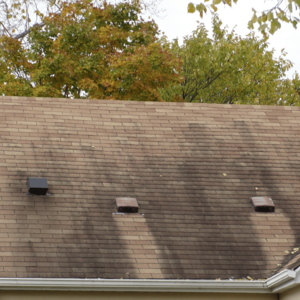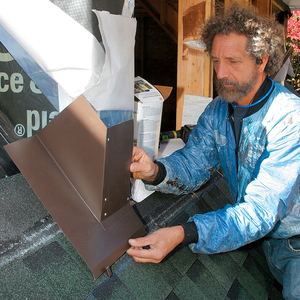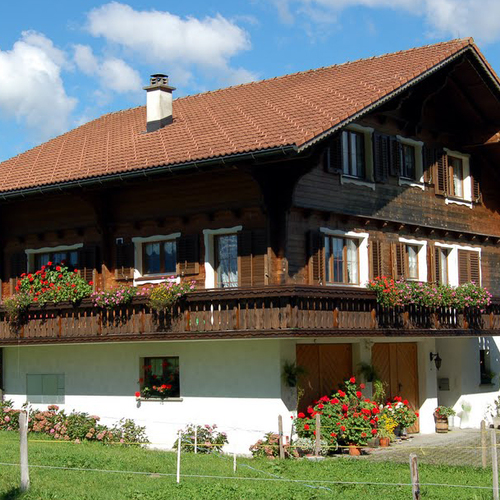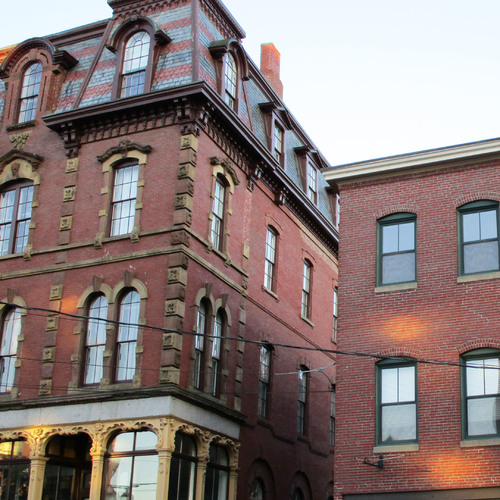
Like all buildings, stucco-clad buildings benefit from roof overhangs. If a stucco building lacks roof overhangs, it needs, at a minimum, some type of coping flashing or roof flashing—flashing with a lip—at the top of the parapet wall. The point of the roof overhang or the extended flashing is to limit the amount of rainwater that dribbles down the wall.
What happens when water dribbles down a stucco wall? Well, the wall stays wet and algae begins to grow. Unsightly algae isn’t fatal, of course, and it is fairly easily covered up by regular repainting. But the need for repainting would be substantially reduced if architects understood the benefits of roof overhangs and dripedges.
Why don’t architects understand these benefits? I’m not sure, but I imagine that it has to do with deficiencies in architecture school curricula.
Overhangs can’t eliminate rain exposure—but they can certainly reduce it
Of course, roof overhangs and flashing dripedges can’t prevent all of the rain from reaching a stuccoed wall; these details can only reduce the amount of water that ends up dribbling down the wall. But reducing the amount of water that dribbles down the wall makes a big difference in the amount of algae on the wall, and a big difference in the frequency of stucco painting.

If you live in an area with lots of stucco, stroll down a few sidewalks and pay attention to algae patterns. You’ll begin to see which types of walls stay clean, and which types of walls develop algae.
Weekly Newsletter
Get building science and energy efficiency advice, plus special offers, in your inbox.

This article is only available to GBA Prime Members
Sign up for a free trial and get instant access to this article as well as GBA’s complete library of premium articles and construction details.
Start Free TrialAlready a member? Log in















7 Comments
"Why don’t architects understand these benefits? I’m not sure, but I imagine that it has to do with deficiencies in architecture school curricula."
To be sure, architecture curriculum will always leave something to be desired, but as evidenced from your photos it looks like some fare better than others.
I've seen similar staining issues on stone-clad facades. It hurts the eyes, and it should rightly stain some egos. Clearly not the result of budget shortcomings..
Architects are seldom trained in building science especially in US schools. It is the repsonsible and prudent Architect that seeks out this information to learn, ask, research and enjoy the fun world of liability insurance that pushes the Architect to detail buildings correctly. However, very few single family buildings are desgned, let alone detailed by Architects. This a building industry failure.
Beyond its unsightliness, the algae most likely indicates that something bad is happening to the wall behind it. Inviting a reservoir cladding to absorb water is in most climates a terrible idea.
I haven't found this to be the case in my testing on thousands of EIFS and stucco buildings. I've seen both cement stucco and EIFS with heavy staining and no interior moisture damage and also the reverse. I would venture that there is a higher chance of moisture damage where there are heavy stains, but this is probably more related to the higher average surface moisture than the staining itself. Sure, the stains indicate where there is moisture concentration on the surface and if there are leaks in the surface, there's going to be more damage there. But there's no direct relationship, and you can't really predict moisture damage simply because of staining.
In addition to surface moisture levels and duration, the stains are also related to sun exposure and shading, wind direction, and especially runoff from certain metal flashings. Zinc and copper kill the algae, even in small amounts. So you can have odd patterns of staining on buildings that have no relationship to the actual patterns of moisture leakage and damage. Unfortunately, we can't use the stains as indicators of where to test for damage, or even a predictor of the likelihood of damage.
Still, Martin's basic message is right on point - architectural features and flashings with drip grooves and kickout details are good, water running down the walls is not so good. That's why I cringe every time I see a "modern, simple" building design with smooth surfaces and no overhangs. Simple and pretty, Ok I guess, but just begging for water problems.
Peter,
Thanks for your observations. I'm grateful for your experience.
Galvanized flashings and copper flashings also kill algae on asphalt shingle roofs. So if you don't like roof algae, install a galvanized steel or copper ridge flashing.
Martin: In my area copper is discouraged or outright prohibited, out of concern that the algae killed will be in a local stream.
Ref: https://www.cityofpaloalto.org/files/assets/public/public-works/engineering-services/webpages/forms-and-permits/cb-const-curooford.pdf "New Palo Alto Ordinance Municipal Code Section 16.09.160(b)
Prohibits Copper Roofing Materials
January 2003"
The amount of copper released per year from copper roofs in the RWQCP service area is estimated to be greater than the annual industrial copper discharges to the RWQCP.
Replacement roofing and gutters on historic structures are exempt, provided that
the roofing material used shall be pre-patinated at the factory.
Bryce,
Very interesting. This is the first time I've heard of this concern. Thanks.
Log in or become a member to post a comment.
Sign up Log in